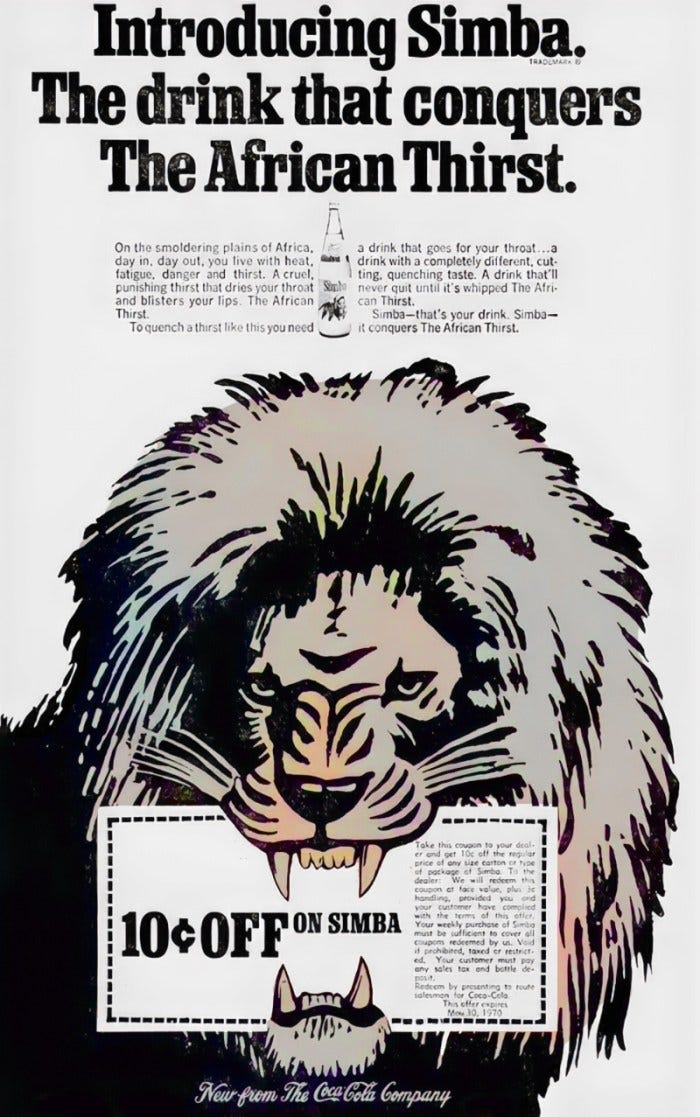
Simba Soda
In the late 1960s, seeing threats from soda lines like Mountain Dew and Squirt, The Coca-Cola Company decided to venture into the world of citrus soft drinks. After conducting extensive market research, they saw opportunity existed and Simba Soda Pop was born. This new soda would be a sugar-sweetened, lemon-flavored citrus soft drink that promised to “conquer the African thirst.”
The name “Simba” comes from the Bantu language Swahili, which means “lion.” The drink’s cans and bottles featured a roaring lion, and the brand used a stylized male lion as its predominant visual element. The original Simba logo had a stylized red sun in place of the dot in the lower case “i” in the yellow lettering of the word Simba. It makes for pretty cool looking packaging.
Development of Simba
If you never had Simba and wonder what it tasted like, most people who have mentioned it to me say it tasted like Mountain Dew or Mello Yello. My sister, who had it many times, claims it was very similar to the latter, which was launched a few years after Simba was pulled from the market.
Simba was developed by a special team of the Coca-Cola Company’s flavor scientists. According to W.R. Windmiller, then-president of the Pacific Coca-Cola Bottling Company, it was a “tart, lemon-flavored sugar-based drink that was not similar to any other soft drinks on the market.” Mountain Dew existed at the time, and while Simba might have not been a clone of it, to say it wasn’t similar is just wrong.
Simba’s Rollout
News of its release hit print in early 1969, when the Chicago Tribune reported that “a new soft drink called Simba from Coca-Cola” was on would be released. When April rolled around, Coca-Cola was ready to make an official announcement. Their new soda, their first new one in three years, had been doing well in test markets in four large cities. The results were encouraging, and they sent the product to their nearly one thousand bottlers in the United States for distribution.
It was a promising start for Simba, but despite the hype, it still hadn’t gone national by the end of 1969. Instead, it was still being introduced to various markets well into 1971. This was not the roaring lion that Coke had hoped for, but they were still sure that success was on the horizon.
To get the word out and get Simba into home, Coca-Cola hired the New York-based brand advertising agency, Tinker Pritchard Wood Associates, in 1968. They would push this “African Thirst” theme. With imagery of Africa and commercials that were actually shot in Africa. The idea was that Africa was so hot that you needed a beverage that could quench the thirst that would develop in that heat.
In a misguided and clumsy attempt to sell the beverage across what they saw as racial lines, they filmed two endings for a commercial that would run in different markets. This was not overlooked by journalists and interest groups at the time, and there was some amount of backlash against this approach.
Here you can see the commercial with both its ending.
How much did Simba cost?
Price could vary by region, but generally by the 1970s a six-pack of 12 oz cans of Simba would cost about $1. This wasn’t too far from the launch price. Although, during the initial launch, they had so many sales to move product that it was easy to find it for half that price.
Between development, production, and marketing, Coca-Cola spent millions of dollars on the Simba rollout. Even though it was developing a following, it just wasn’t meeting sales expectations and by 1972, the product was unceremoniously withdrawn from store shelves. Still it lives on in the memories of people who got to enjoy it and perhaps was the basis for Mello Yello.
Did you get to try Simba? Do you remember what it tasted like? I would love to hear from you if you did.









